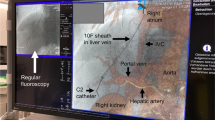Abstract
Background
Opponents of the routine use of intraoperative cholangiography (IOC) express concern over its technical difficulty and the length of time it takes.
Aim
To evaluate the impact of our cystic duct cannulation (CDC) technique, as implemented by one consultant and his trainees, on the IOC time.
Methods
IOC is done routinely in all the laparoscopic cholecystectomies (LCs) undertaken in our unit. We carried out a prospective audit over a period of 18 months, recording the IOC time in consecutive patients undergoing laparoscopic cholangiography (LC) with and without laparoscopic common bile duct exploration (LCBDE). The total IOC time was considered to consist of two components: cystic duct cannulation (CDC) time and fluoroscopy time. The IOC time was further analysed according to the difficulty of cannulation and the operator experience. Special consideration was given to the LCBDE cases. We also describe the detailed steps of our CDC technique.
Results
Over a period of 18 months 243 patients underwent LC. IOC was completed in 240 patients (98.8% success rate). Of those, 194 were females (81%). The mean age was 50 years (range 18–85 years). The mean total IOC time was 6 min, with a CDC time of 2 min, and fluoroscopy time of 4 min. On further analysis, CDC was considered easy in 86% of cases with a mean CDC time of 1.5 min and total IOC time of 4.3 min. When cannulation was difficult (14% of cases) a cholangiography clamp had to be used to prevent leakage of contrast. In difficult cases, the CDC and IOC mean times were 5 and 8.5 min, respectively. As would be expected, trainees spent more time performing cannulation and completing the IOC than the specialist surgeon (3.8 versus 1.8 min, and 7.2 versus 5.6 min, respectively). These differences were statistically but not clinically significant. Similarly, the IOC time was also significantly increased in LCBDE (13 min). This was mainly due to an increase in fluoroscopy time (10 min) rather than CDC time (3 min).
Conclusion
The IOC time could be optimised by using a simple and learnable cannulation technique to less than 5 min in most LCs. Surgeons should not, therefore, refrain from using this important investigation on selective or routine basis, subject to their policy for dealing with patients with suspected bile duct stones.




Similar content being viewed by others
References
Cuschieri A, Croce E, Faggioni A, Jakimowicz J, Lacy A, Lezoche E, Morino M, Ribeiro VM, Toouli J, Visa J, Wayand W (1996) EAES ductal stone study. Preliminary findings of multi-center prospective randomized trial comparing two-stage vs single-stage management. Surg Endosc 10(12):1130–1135
Ladocsi LT, Benitez LD, Filippone DR, Nance FC (1997) Intraoperative cholangiography in laparoscopic cholecystectomy: a review of 734 consecutive cases. Am Surg 63(2):150–163
Soper NJ, Dunnegan DL (1992) Routine versus selective intra-operative cholangiography during laparoscopic cholecystectomy. World J Surg 16(6):1133–1140
Cuschieri A, Shimi S, Banting S, Nathanson LK, Pietrabissa A (1994) Intraoperative cholangiography during laparoscopic cholecystectomy. Routine vs selective policy. Surg Endosc 8(4):302–305
Edye M, Dalvi A, Canin-Endres J, Baskin-Bey E, Salky B (2002) Intraoperative cholangiography is still indicated after preoperative endoscopic cholangiography for gallstone disease. Surg Endosc 16(5):799–802
Ludwig K, Bernhardt J, Steffen H, Lorenz D (2002) Contribution of intraoperative cholangiography to incidence and outcome of common bile duct injuries during laparoscopic cholecystectomy. Surg Endosc 16(7):1098–1104
Flum DR, Flowers C, Veenstra DL (2003) A cost-effectiveness analysis of intraoperative cholangiography in the prevention of bile duct injury during laparoscopic cholecystectomy. J Am Coll Surg 196(3):385–393
El Shallaly G, Seow C, Sharp C, Mughrabi A, Nassar AH (2005) Intraoperative cholangiography time in laparoscopic cholecystectomy: timing the radiographer. Surg Endosc 19(10):1370–1372
Petelin JB (2003) Laparoscopic common bile duct exploration. Surg Endosc 17(11):1705–1715
Borie F, Millat B (2003) Intraoperative cholangiography by laparoscopy. Why and how to do it? (abstract) J Chir (Paris) 140(2):90–93
Millat B, Deleuze A, de Saxce B, de Seguin C, Fingerhut A (1997) Routine intraoperative cholangiography is feasible and efficient during laparoscopic cholecystectomy. Hepatogastroenterology 44(13): 22–27
Nathanson LK, O’Rourke NA, Martin IJ (2005) Postoperative ERCP versus laparoscopic choledochotomy for clearance of selected bile duct calculi: a randomised trial. Ann Surg 242(2):188–192
Ledniczky G, Fiore N, Bognar G, Ondrejka P, Grosfeld JL (2006) Evaluation of perioperative cholangiography in one thousand laparoscopic cholecystectomies. Chirurgia (Bucur) 101(3):267–272
Pisano G, Licheri S, Dazzi C, Erdas E, Pomata M, Daniele GM (2005) Operative cholangiography during laparoscopic cholecystectomy: considerations about routine or selective policy. G Chir 26(8–9):333–337
Vezakis A, Davides D, Ammori BJ, Martin IG, Larvin M, McMahon MJ (2000) Intraoperative cholangiography during laparoscopic cholecystectomy. Surg Endosc 14(12):1118–1122
Jones DB, Dunnegan DL, Soper NJ (1995) Results of a change to routine fluorocholangiography during laparoscopic cholecystectomy. Surgery 118(4): 693–701
Caprini JA (1994) Cost-effective laparoscopic cholangiography. Surg Laparosc Endosc 4(2):142–145
Thompson JE Jr, Bennion RS (1989) A simple, cost-effective method for operative cholangiography. Am J Surg 158(5):461–462
Hamouda AH, Goh W, Mahmud S, Khan M, Nassar AHM (2007) Intraoperative cholangiography facilitates simple transcystic clearance of ductal stones in units without expertise for laparoscopic bile duct surgery. Surg Endosc 21(6):955–959
Amott D, Webb A, Tulloh B (2005) Prospective comparison of routine and selective operative cholangiography. ANZ J Surg 75(6):378–382
Author information
Authors and Affiliations
Corresponding author
Additional information
Oral presentation at the 2005 EAES congress, Venice, Italy: “Optimising cystic duct cannulation and intraoperative time for consultants and trainees in laparoscopic cholecystectomy and common bile duct exploration”.
Rights and permissions
About this article
Cite this article
Nassar, A.H.M., El Shallaly, G. & Hamouda, A.H. Optimising laparoscopic cholangiography time using a simple cannulation technique. Surg Endosc 23, 513–517 (2009). https://doi.org/10.1007/s00464-008-9853-8
Received:
Revised:
Accepted:
Published:
Issue Date:
DOI: https://doi.org/10.1007/s00464-008-9853-8




